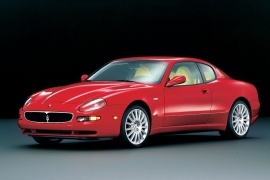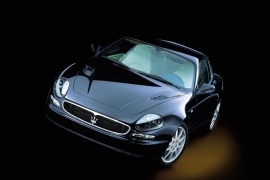MASERATI Coupe Models/Series Timeline, Specifications & Photos
First production year: 1998
Engines: Gasoline
Body style: Coupé (two-door)
In 2002, Maserati changed the older 3200 GT to a new vehicle named Coupe. While the name was new, the look was almost the same as its predecessor. Some could say it was a major facelift.
The 2002 Maserati Coupe was launched at the Detroit Auto Show. It was the closed version of the Maserati Spyder, which was unveiled at the 2001 Frankfurt Motor Show but it offered the rigidity and the usability of a true Gran Turismo vehicle, with four seats and a large enough trunk for a trip around the continent.
The Coupe featured the classical look of a GT car with front engine and rear-wheel-drive. The long hood covered a V8 engine pushed to the back to help to balance the weight distribution. The headlights were protected by a glass and the grille with the trident badge on it was surrounded by a chromed rim. It was styled by Giorgetto Giugiaro from the ItalDesign institute.
Inside, the Coupe offered four seats, but with limited room for the rear passengers. The leather-wrapped dashboard and center console were different than the older 3200 GT. Despite being a performance car, it was fitted with comfort-oriented front seats instead of sport-bucket ones. The infotainment unit was amplified by a high-end audio system.
The 4.2-liter engine was produced by Ferrari and it offered more power than the previously turbocharged unit installed in the 3200 GT. The standard gearbox was a 6-speed manual, but a sequential 6-speed, named Cambiocorsa was offered as an option.
Maserati replaced the Shamal lineup in 1998 with the 3200 GT, a vehicle that redefined the styling of the Italian brand for decades due to its curved panels and waved-shaped lines.
The Italian brand was a well-known brand in motorsports history, having won at Indianapolis, Nurburgring, and other endurance races. But after decades of struggle with financial problems, the automaker ended up in Fiat's brands' portfolio in 1993, and the resurrection process began. As a result, the first product was this: the 1998 3200 GT, a grand tourer made with luxurious features and a sporty-looking shape.
While the bodywork was completely new, some of its underpinnings were carried over from its four-door stablemate, the Quattroporte Evoluzione, to cut development costs. But those were money well saved and spent on the Italdesign Giugiaro design studio, which penned one of the most beautiful GTs on the market at that time. The effort paid off, and Maserati sold almost 5,000 units of it until its replacement arrived in 2002.
With its long hood and short cabin, the 3200 GT sported the organic shapes of the bio-design era when the car appeared on the market. At the front, the headlights covered by clear glass panels were flush with bodywork despite being placed on the front edges of the fenders.
The broad grille placed on the bumper sported the chromed "Tridento" badge of the automaker and was flanked by the turn signals. Lower, on the apron, the automaker added an air intake for additional cooling.
From its profile, the ascending waistline formed a waved shape that raised towards the C-pillars above the muscular rear quarter panels. A short deck followed the sloped-down rear window, ending the vehicle. On the rear fascia, Giugiaro created one of the most unique design cues in the industry, with boomerang-shaped slim taillights extended from the trunk lid to the quarter panels. These were the first LED taillights fitted on a production vehicle in the automotive industry.
Inside, the automaker created a luxurious, leather-wrapped cabin with high-bolstered bucket seats at the front and a bench seat profiled for two passengers in the back. The dashboard sported a double-wave shape, with round vents and an oval-shaped analog clock on the center stack. Other rounded elements were noticed on the center console that divided the cockpit into two distinct areas.
In front of the driver, Maserati installed an elegant instrument cluster that housed the large dials of the speedometer and tachometer and four additional gauges that monitored the engine status and the fuel level. The automaker provided enough room in the back for two adults; although not very generous, it was still usable, with a folding armrest in the middle.
Under the hood, the 3200 GT featured a 3.2-liter twin-turbocharged V8 powerplant that was paired with either a six-speed manual or a Borg-Warner four-speed automatic gearbox. Power went to the rear wheels via a limited-slip differential.

